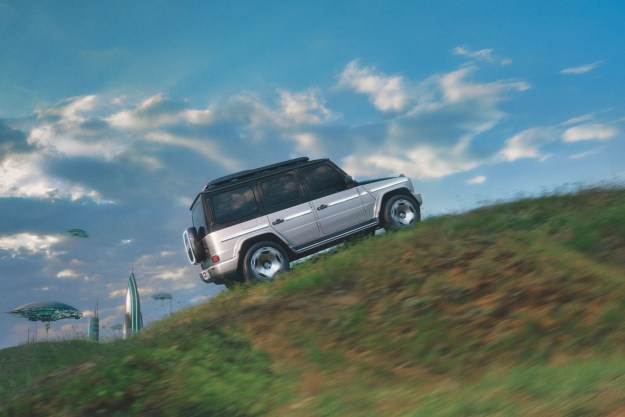August’s annual Bonneville Salt Flats Speed Week doesn’t mark the end of the go-fast season, even if it is the most famous event. The Land Speed World Finals are scheduled for October 3 to 6, 2017, at the Salt Flats, weather permitting. If you’re going to Bonneville for the first time, our Salt Flats Survival Guide can help you avoid everything from hearing impairment to burnt nethers.
The Southern California Timing Association (SCTA) hosts Speed Week and the World Finals. The SCTA’s one-page Helpful Hints for Spectators explains the event but doesn’t say much about personal protection beyond wearing a hat and staying in the shade. By “shade” they mean tarps or pop-ups because what you see in the photo below is where it all happens. Notice the lack of trees, buildings, or anything else that could make shade.
This year, Digital Trends was “on the Salt” for the 50th anniversary Spirit of Munro run during Speed Week. It was my first trip to the Salt Flats and even though many people offered advice in advance, I wasn’t fully prepared. That’s why we decided to write this survival guide.
Why plan?
The Bonneville Salt Flats aren’t on the moon, they only look that way. You can camp for free on adjacent Bureau of Land Management (BLM) property while attending Salt Flats events, but there are no facilities in the camping area – just desert. Bring food and water, too, as the nearest town is 12 miles away.
The way many people get to the Bonneville Salt Flats is to fly to Salt Lake City and rent a car. Leave the airport and take the first right onto 80 west. The highway is straight and fast for 110 miles to exit 4. The speed limit is 80. In two trips I saw zero state troopers. I wasn’t driving, but guess how fast most vehicles were traveling.
You’ll see the Salt Flats on your right before you get to the exit. When you get off there’s a gas station, a restaurant, and a couple of small stores and that’s it.
Salt Flats survival guide
Desert-related factors

Is it really salt?
Salt Flats salt really is salt. I didn’t taste it myself, but three other journalists did. All agreed it had an extremely strong, harsh, “salty” taste. No one said, “Oh yum, that’s awesome.” I’m happy to learn from others’ experiences when it comes to tasting something that’s been lying in the open on the ground, possibly for thousands of years.
Dehydration
You’re in the desert under the sun. It’s dry. You dehydrate quickly if you do not drink plenty of fluids. Coffee and alcohol aren’t much help. The best bet is water. If you begin to feel thirsty, you’re already partially dehydrated. If you don’t drink it will get worse and sometimes the “worse” part can come on suddenly. This I know from previous personal experience. Drink at least twice as much as you normally do.
Sunscreen
Spending the day on salt in the desert is intense and tricky. You have to use sunscreen and refresh it every few hours.
The tricky part is the salt reflects the sun. Put sunscreen on parts of your body you may not generally protect, like under your chin, under your nose, and even the bottoms of your ears. If you wear shorts with loose legs, you stand a realistic chance of sunburn on parts of your body where it can be extremely uncomfortable, not to mention embarrassing. ‘Nuff said.
Hats
Hats are a good thing at Bonneville. Salt Flats vets wear silly looking hats with huge floppy brims that shade their shoulders, chest, back, and upper arms in addition to covering their heads.
Sunglasses
Sunglasses will help protect your eyes, not only from the sun, but also from the reflection of the sun off the salt. The reflected sun may not be as bright as the sun itself, but it can still be very tiring. Good sunglasses can also help you see tiny cars miles in the distance traveling at extremely high speeds.
Lip balm
Lip balm may not be necessary for everyone, but if you use it when you’re not on the desert, you definitely will need it on the Salt Flats. If you need lip balm when you’re in Vegas, you’ll need it here, too.
SCTA officials told us any shoes we wore on the salt would be ruined within a couple days.
Shoes
SCTA officials told us any shoes we wore on the salt would be ruined within a couple days. I wore an old pair I’ve been meaning to throw out. They were fine after I brushed off the salt. Not a big deal.
Pants
Pants are better than shorts while you’re on the Salt Flats. Not only will pants protect from the sun, but also from blowing sand or salt. In three days I never saw anyone wearing a skirt or a dress. Jeans are the most common lower attire.
Shirts
Long-sleeved shirts protect your arms better than short sleeves for sure, but it looked like most people wear t-shirts and just slather on sunscreen.
Desert wind
Desert winds came up quickly three times in the four days while we were at Bonneville. The wind rose quickly in the twice in the evening when we were in the Indian Motorcycle RV compound.
A very strong wind came through during the day while we were in the pit area. There are no trees in the desert and in Bonneville there are no hills or buildings, so there’s nothing to stop the wind. You have to be extra careful because the wind not only blows sand, but at Bonneville it can be blowing salt as well, even if you’re miles away from the actual Salt Flats.
Sweeping salt
Indian Motorcycle hosted a group of journalists at Speed Week specifically to watch Lee Munro drive a partially streamlined new Indian Scout to celebrate his great grand-uncle’s 1967 world-record run. Lee made several runs over the course of four days. The video below shows him prepping for and taking off on the first run.
We stayed in RVs in the desert. During the day the same RVs were driven onto the salt to Indian’s pit area. People were in and out of the RVs all day.
Even if you scraped your shoes it was impossible not to track salt everywhere. I took it on myself to sweep out our RV and clean the salt off the steps several times a day. Desert salt sweeps like slightly wet snow.
Event-related factors
Earplugs
I wondered before the trip if earplugs would be necessary but decided not to bring any. That was a mistake. The vehicles that vie for land speed records are loud. Especially near the starting line. (See notes about press vests below.)
Cars out of control spinning toward the crowd at 400 mph
The SCTA officials warned us about many things when we checked in and registered for our press passes and vests. One warning got our total attention.
You need to be vigilant at all times on the Salt Flats. Many of the viewing points for the Salt Flats three land speed record courses are as close as a quarter mile to the track. If a vehicle spins out at close to 400 mph, a quarter mile is only 2.25 seconds away.
And yeah, most likely the speed would decrease, but if a 40-foot long streamliner is spinning in your direction across the flat desert with no obstructions, don’t argue, get out of the way as best you can.
Nitrous blowback is bad for cameras (not to mention humans)
We also were advised by SCTA officials not to stand behind or too near vehicles burning nitrous. They emit harmful particles and vapor in their exhaust that can quickly pit and destroy camera equipment. Not to mention human skin and eyes.
Advantages of press vests
Registered members of the press are issued brightly-colored, numbered vests at Bonneville. The numbers on the vests serve two purposes: to be sure the vests were returned and to identify your body in case you weren’t paying attention when that streamliner started spinning in your direction at 400 mph.
Thanks to the vests we were able to cross security lines and get right next to the vehicles about to start their runs and speak to their drivers, their crew, and the track officials. The access was excellent.
Disadvantages of press vests
Because you have a press vest, you can find yourself very close to vehicles that create make eardrum-splitting noise levels. You can also behind those nitrous-burning vehicles with your expensive cameras and precious skin and eyes.
The video below is an example of a car that made a serious amount of noise. I was too close but so was everyone else. Even the track officials with headsets grabbed their ears.
Everyone is friendly
Attendees at Speed Week were universally friendly. While the drivers are all competing, they’re competing with themselves for their personal best. It was apparent that everyone was rooting for everyone else.






